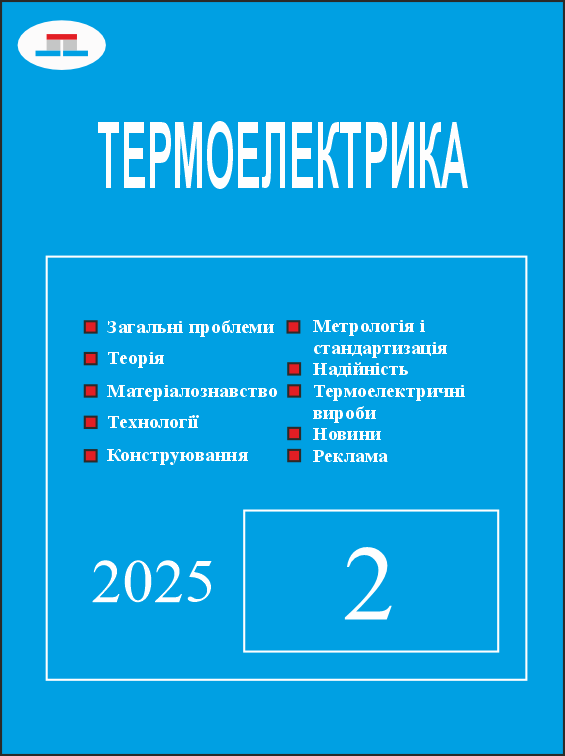Розрахунок рухливості носіїв заряду у PbTe на основі емпіричних термоелектричних параметрів
DOI:
https://doi.org/10.63527/1607-8829-2025-2-36-48Ключові слова:
рухливість, коефіцієнт Зеебека, питома електропровідність, ефективна масаАнотація
У роботі проведено порівняльний аналіз рухливості носіїв заряду у PbTe розрахованої з використанням виразів отриманих на основі моделі Друде-Зомерфельда та моделі невиродженого напівпровідника з параболічними зонами. При цьому рухливості розраховувались як функції експериментально визначених коефіцієнта Зеебека та питомої електропровідності. Результати співставлено з відповідними даними отриманими в наближенні часу релаксації.
Посилання
1. Joffe, A. F., & Stil’bans, L. S. (1959). Physical problems of thermoelectricity. Reports on Progress in Physics, 22(1), 167–203. https://doi.org/10.1088/0034-4885/22/1/306
2. Gelbstein, Y., & Davidow, J. (2014). Highly efficient functional GexPb1−xTe based thermoelectric alloys. Physical Chemistry Chemical Physics, 16, 20120–20126. https://doi.org/10.1039/C4CP02399D
3. Khshanovska, O., Parashchuk, T., & Horichok, I. (2023). Estimating the upper limit of the thermoelectric figure of merit in n- and p-type PbTe. Materials Science in Semiconductor Processing, 160, 107428. https://doi.org/10.1016/j.mssp.2023.107428
4. Ni, J. E. (2012). Powder processing and mechanical properties of Ag₀.₈₆Pb₁₉SbTe₂₀ (LAST) and Pb₀.₉₅Sn₀.₀₅Te - PbS 8% (PbTe-PbS) thermoelectric materials (Doctoral dissertation, Michigan State University).
5. Snyder, G. J., Snyder, A. H., Wood, M., Gurunathan, R., Snyder, B. H., & Niu, C. (2020). Weighted mobility. Advanced Materials, 32(20), 2001537. https://doi.org/10.1002/adma.202001537
6. He, W., Qin, B., & Zhao, L.-D. (2020). Predicting the potential performance in p-type SnS crystals via utilizing the weighted mobility and quality factor. Chinese Physics Letters, 37(8), 087104. https://doi.org/10.1088/0256-307X/37/8/087104
7. Qin, B., He, W., & Zhao, L.-D. (2020). Estimation of the potential performance in p-type SnSe crystals through evaluating weighted mobility and effective mass. Journal of Materiomics, 6, 671–676. https://doi.org/10.1016/j.jmat.2020.06.003
8. Askerov, B. M. (1994). Electron transport phenomena in semiconductors. https://doi.org/10.1142/1926
9. Pei, Y., LaLonde, A. D., Wang, H., & Snyder, G. J. (2012). Low effective mass leading to high thermoelectric performance. Energy & Environmental Science, 5, 7963. https://doi.org/10.1039/c2ee21536e
10. Zayachuk, D. M. (1997). The dominant mechanisms of charge-carrier scattering in lead telluride. Semiconductors, 31(2), 173–176. https://doi.org/10.1134/1.1187322
11. Knura, R., Parashchuk, T., Yoshiasa, A., & Wojciechowski, K. T. (2021). Origins of low lattice thermal conductivity of Pb₁−ₓSnₓTe alloys for thermoelectric applications. Dalton Transactions, 50(12), 4323–4334. https://doi.org/10.1039/d0dt04206d
12. Chesnokova, D. B., & Kamchatka, M. I. (2001). Modeling of defect formation in lead chalcogenides and their properties. Inorganic Materials, 37(2), 111–118. https://doi.org/10.1023/A:1004189006526
13. Sealy, B. J., & Crocker, A. J. (1973). The P-T-x phase diagram of PbTe and PbSe. Journal of Materials Science, 8, 1737–1743.




